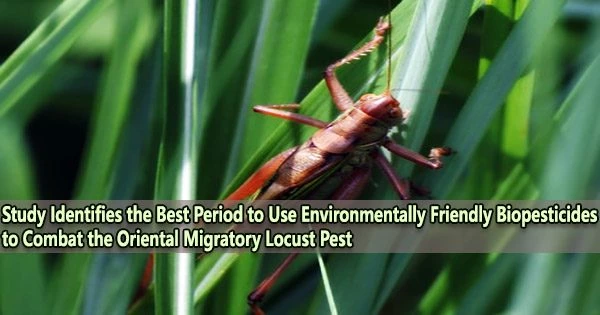The best time to employ biopesticides that are easier to use and more ecologically friendly to combat the Oriental migratory locust pest has been uncovered by a recent study headed by researchers from the Chinese MARA-CABI Joint Laboratory for Biosafety.
One of the most hazardous pests impacting crop output and food security in China is the locust migratoria manilensis. Crops at risk include maize, rice and peanut. Pastures can also be seriously damaged.
Despite the absence of significant outbreaks in recent years, high-density populations of the Oriental migratory locust still exist in the marshes of the provinces of Jilin, Shanxi, and Shandong, endangering food production and the ecosystem of the area.
Dr. Hongmei Li, lead author and Senior Scientist at CABI in China, together with fellow scientists including those from the National Agro-Tech Extension and Service Center, Beijing, Zhejiang University and the University of Cordoba, Spain, suggest that the body heat of the locusts is key to effectiveness of the biopesticides.
The researchers point out that although entomopathogenic fungi (EPF) are frequently advertised as a way to combat the Oriental migratory locusts with fewer toxic pesticides, they really have a tendency to function best on insects with lower body temperatures.
Dr. Hongmei Li and the scientists argue that biopesticides should be applied on younger locusts at dawn or dusk as they tend to show lower temperatures more suitable for EPF development thereby minimizing the risk of a locust outbreak.
Entomopathogenic fungi are more effective if the body temperature of the target pest is in a proper range without being too high or too low. The application of biopesticides, therefore, should focus on younger locusts spraying in the morning or at dusk when the locusts have lower body temperatures.
Dr. Hongmei Li
Dr. Hongmei Li said, “Current pest management techniques would benefit from understanding the behavioral rhythms of the target pest and its body temperature, a critical aspect not well studied and potentially limiting the effectiveness of biopesticides under natural conditions.”
The study published in Frontiers in Physiology sought to understand the behavioral patterns of different stages of hoppers and adults of the Oriental migratory locust and the environmental factors that modulated their body temperatures through field observation.
Intensive field sampling in two of the main breeding regions in China was carried out. This included recording the day and night body temperatures of 953 locusts as well as their morphological traits (stage, sex and size) and microhabitat.
Dr. Hongmei Li added, “The results revealed that locusts preferred the ground as their main activity sub-habitat, particularly for hoppers. Adults tended to move upper in the reed canopy at two peaks 10am to 11am and 2pm to 3pm. Locusts body temperature during the daytime increased with development stage and size, while the opposite pattern occurred at night time.”
“Entomopathogenic fungi are more effective if the body temperature of the target pest is in a proper range without being too high or too low. The application of biopesticides, therefore, should focus on younger locusts spraying in the morning or at dusk when the locusts have lower body temperatures.”
The scientists stress in their conclusion that future improved technologies used to combat crop pests may also benefit from the ground truth data of the bugs they have detected. This covers applications based on agriculture and other forms of earth observation.
















